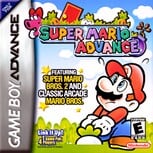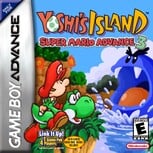Super Mario Advance (series)
Template:Series-infobox The Super Mario Advance series is a series of video game remakes for the Game Boy Advance. Each game contains one of the classic Mario sidescrollers, with improved graphics, sound, and additional features. Also, each game contains an updated version of the 1983 arcade game Mario Bros.
Multi-Player mode
A game from the Super Mario Advance series can link up to other Game Boy Advances. This allows two people to play a version of the two-player Mario Bros., with better graphics, control, and sound.
Also, up to four GBAs can link up to each other and play a special, 4-player version of Mario Bros. The object in this version is to collect coins. Coins appear when an enemy is defeated. Whoever gets five coins first, wins. The most notable added feature is the trash can. Players can pick up and throw each other, and players can be thrown in the trash can. A player in the trash can is stuck there for several seconds, putting them at a disadvantage, but will come out with an item that helps them fight the other players.
Games
| Title, Original Release and System | Overview |
|---|---|
| Super Mario Advance
|
Super Mario Advance features the classic game Super Mario Bros. 2, basing it heavily off of the Super Mario All-Stars port of the game, although in the game it is referred to as Super Mario 2. Nintendo's decision to choose this title as a Game Boy Advance launch game was seen by some as misguided; GameSpot in particular thought that Super Mario Bros. 3 or Super Mario World would have been a far better choice for a launch title considering their popularity. (Both of these titles would ultimately be remade as part of the SMA series, possibly as a result of GameSpot's review.) Nonetheless, IGN praised the choice, calling it "one of the most polished and creative platformers of the era," and it was a best-selling launch game. Recently, the game has become a part of the Player's Choice lineup for the Game Boy Advance as one of the system's first three player's-choice games (along with Mario & Luigi: Superstar Saga and Super Mario Advance 3.) It was the first Mario game for the Game Boy Advance and was released in 2001. |
| Super Mario World: Super Mario Advance 2 File:Super Mario Advance 2 Box Art.jpg |
As the name suggests, Super Mario World: Super Mario Advance 2 features Super Mario World. It was the second video game in the Super Mario Advance series. |
| Yoshi's Island: Super Mario Advance 3 |
Yoshi's Island: Super Mario Advance 3 is a remake of Super Mario World 2: Yoshi's Island for the Game Boy Advance. It is very much like the original version, but with improved sprites, new levels and Yoshi voices from Yoshi's Story. |
| Super Mario Advance 4: Super Mario Bros. 3 File:Super Mario Advance 4 Box Art.jpg |
In 2003, the fourth and final entry in the Super Mario Advance series, Super Mario Advance 4: Super Mario Bros. 3 was released for the Game Boy Advance. It was actually a heavily updated version of Super Mario Bros. 3 as the name suggests. However, it boasted similar graphics and sound to the All-Stars version. It features a save system similar to the Super Mario All-Stars save system, except temporary saves may now be done anywhere. This game's largest added feature was compatibility with the e-Reader and e-Cards. These cards could be scanned in to the game, and would function as new levels, instant power-ups, or demos. One power-up card features a power-up that cannot be found in any other Mario game: the Boomerang. |
Beta Elements
- For a list of this series beta elements, see here.

